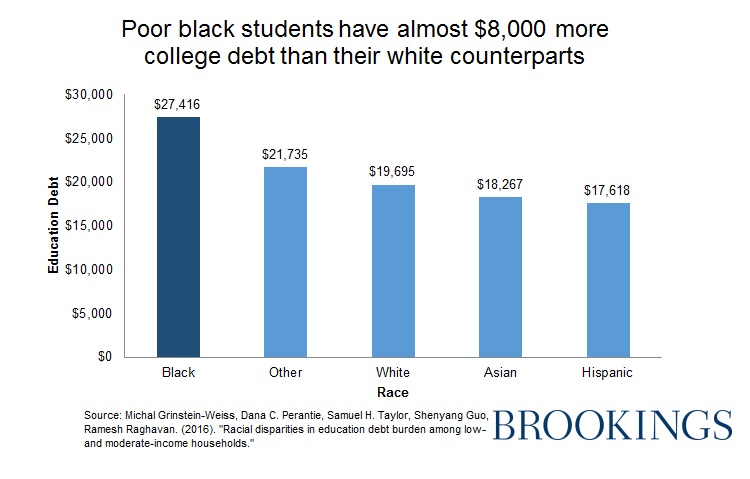Student debt is an inequality problem. Borrowing to invest in a good college education is a sound investment for many, if not most, young people. Debt is a problem for those who borrow expensively to attend poor-quality institutions. And the debt problem has a strong racial dimension.
Race gaps in indebtedness are larger than previously realized, according to a study published Friday in Children and Youth Services Review. The authors–Michal Grinstein-Weiss, Dana C. Perantie, Samuel H. Taylor, Shenyang Guo, and Ramesh Raghavan–restricted their analysis to people with low or modest incomes to highlight gaps by race rather than class. Their conclusion:
“Differences in [socio-economic status] and college completion rates cannot fully account for racial disparities in education debt: The risks faced by minorities in the course of financing a college degree can differ substantially from those faced by Whites of similar economic and educational standing.”
Black and Hispanic students are both more likely to take on debt and to take on more debt than white and Asian students, they found. (Asian students are 40% less likely than whites to borrow for college, the study reports.) The result is a significant race gap in overall student-debt burdens. The black-white gap for low- and middle-income respondents is estimated to be $7,700, a disparity about twice as wide as that found in previous studies.
Why are the debt gaps between races so stark? White and Asian students even from families with low and moderate incomes may have access to greater economic support from their family. A separate recent study found that black students receive less help paying for college from their parents compared with white students who have similar levels of family wealth. It’s also possible that there are different attitudes toward taking on debt between people in particular racial categories.
But the most likely explanation for the race gap, among those considered by the authors, is that black and Hispanic students go to different post-secondary institutions. In particular, they are more likely to attend for-profit schools, which are poor value for money by comparison to state schools and other colleges.
The U.S. higher education system is “an inequality machine,” Georgetown scholar Anthony Carnevale has suggested. This looks to be true not just in terms of income gaps but also for race.
Editor’s note: This piece originally appeared in The Wall Street Journal’s Washington Wire.




Commentary
Op-edThe (bigger than we realized) role race plays in college debt
May 2, 2016